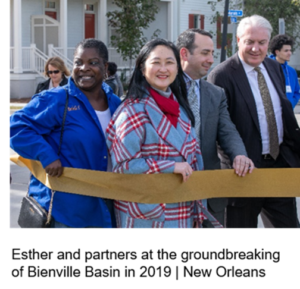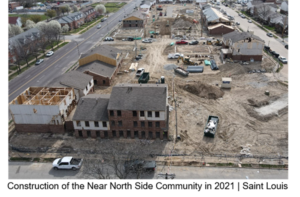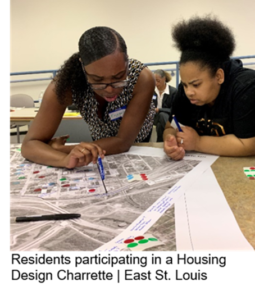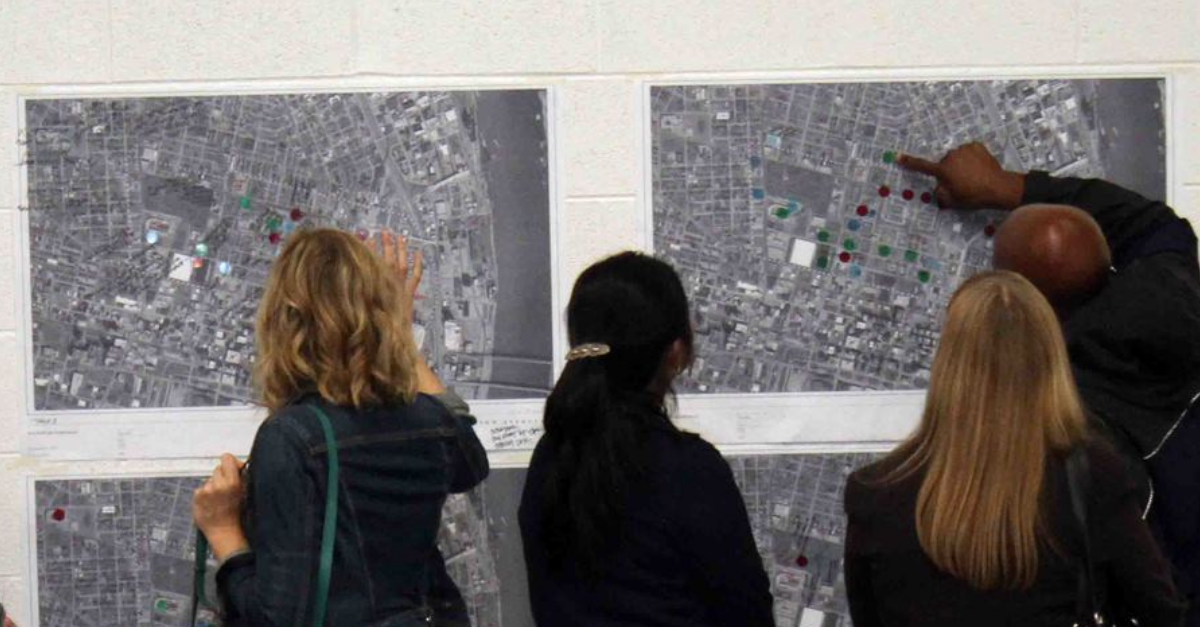Physical Development Creates Stable Housing
 Housing matters. Decent, affordable, safe housing makes a difference in a family’s health and economic outcomes. But years of disinvestment in communities of color and years of systemic racism have created inequitable access to safe, quality, and affordable housing in communities of opportunity. As a result, low-wealth families end up spending a disproportionate amount of their income on housing — sometimes over 50% — putting them at greater risk for housing instability, substandard housing conditions, and negative social outcomes.
Housing matters. Decent, affordable, safe housing makes a difference in a family’s health and economic outcomes. But years of disinvestment in communities of color and years of systemic racism have created inequitable access to safe, quality, and affordable housing in communities of opportunity. As a result, low-wealth families end up spending a disproportionate amount of their income on housing — sometimes over 50% — putting them at greater risk for housing instability, substandard housing conditions, and negative social outcomes.
Frequent moves have been associated with negative health outcomes in children, and poor housing conditions impact physical health, child development and other social factors. Children who move frequently are more likely to have chronic conditions and poor physical health. They may also be less likely to have consistent health insurance coverage (Healthy People 2000). Providing quality, safe, affordable housing is importable for stabilizing low wealth families.
Recognizing this, the Internal Revenue Service, through State Financing Agencies, has provided a basis boost for Qualified Census Tracts (QCT). This has incentivized the creation of high-quality, safe housing that is affordable for low-wealth families who live in these census tracts. Particularly, tax credits have been an effective vehicle for private developers to expand low-income housing to communities nationwide.
The Low-Income Housing Tax Credit (LIHTC or tax credit), the nation’s largest affordable housing development program, has created over two million affordable homes for low-income families, seniors, and populations with special needs since its enactment in 1986. Through tax credit-supported construction, income-eligible residents are provided long-term stable housing and, for many, wrap around supportive services such as intensive case management, job coaching, parenting support, and health resources that improve their quality of life and prospects for the future.
Supportive Housing Creates Thriving Communities
 Interest has grown in developing strategies to link families receiving HUD assistance with services to help them move toward economic independence, and the results are clear.
Interest has grown in developing strategies to link families receiving HUD assistance with services to help them move toward economic independence, and the results are clear.
For example, demonstration programs in Chicago and Denver, documented by the Urban Institute, have shown that for highly vulnerable populations, supportive housing increases people’s housing stability, reduces their criminal justice system interactions, increased employment, reduces anxiety, results in more stable physical health, and improves their access to appropriate health care.
Work by USI demonstrates the importance of supportive housing services with specific, quantifiable results, which can be viewed on the USI website through community dashboards. For example, most recently, those living in supportive housing in Memphis, Baltimore, and Galveston have had an over 30% increase in their earned income while participating in the USI supportive housing case management programs. In Miami, the percentage of young children enrolled in early learning programs grew from 5% to 68% while their families were engaged in USI’s supportive housing. In Fort Worth, 95% of residents had a primary care physician in 2020 compared to 55% in 2018.
Moving people to work, improving health outcomes, changing education trajectories, and creating safer communities — These results aren’t magic. They come from consistent; intensive family supports by culturally competent, trained on-site staff and partnering with residents and neighborhood stakeholders. Having worked in the field for over four decades, USI has learned that affordable housing creates a pathway to physical equity, while supportive services help to create social equity.
Here’s an example:
Starting in 2017, USI began to incorporate Safety, Mastery & Connection, also known as Trauma-Informed Care, in its family support model to deepen support to families in communities. USI recognizes that the long-term effects of primary and secondary trauma experienced by families living in low-wealth communities has an impact on a family’s ability to thrive. Addressing trauma became evident in attempting to move able-bodied adults to work. USI staff, across most of its sites, learned that a significant barrier for moving to work was convincing mothers to place their children into early learning. Many support programs would identify this barrier as a lack of education on of the importance of early learning programs, compliance or access issues, or worse mental models about laziness and welfare that get attached to our families every day. Instead, our Family Support staff conducted focus groups and a factor analysis and implemented strategies to address the real core issue: the parents’ childhood trauma and concerns over the safety of their children in early learning programs. Simply developing technical strategies such as increasing the number of early learning slots or education about the importance of high-quality childcare would do little to address the core issue. Instead, USI Family Support staff had to develop adaptive strategies such as certifying parents as family-based childcare centers so that they can watch their children and earn a living and/or linking parents to culturally competent mental health services to address the trauma. This example highlights the importance of long-term relationships that build trust, how our pillars are intertwined, and how an unfunded light touch program would have never gotten to the core factors and made any difference in the results.
Often, these critical supportive services are expected or even required of developers for LIHTC eligibility without backing to cover their ongoing costs. The LIHTC program, in effect, provides short-term funding for a long-term mandate.
A Deeper Dive into LIHTC
 Created under the Tax Reform Act of 1986 and made permanent in 1993, LIHTC gives incentives for utilizing private equity in the development of affordable housing aimed at low-income Americans. To receive the credits, owners must commit to strict affordability standards for at least 15 years, creating long-term stability – and opportunity – for low-income residents.
Created under the Tax Reform Act of 1986 and made permanent in 1993, LIHTC gives incentives for utilizing private equity in the development of affordable housing aimed at low-income Americans. To receive the credits, owners must commit to strict affordability standards for at least 15 years, creating long-term stability – and opportunity – for low-income residents.
LIHTC, when developed in QCT, allows a 30% boost to help offset construction costs associated with redevelopment. A 30% basis boost in simple math means every eligible dollar spent generates $1.30 of eligible basis. This will generally result in up to a 30% increase in LIHTC and equity. To qualify, QCTs must have 50% of households with incomes below 60% of the Area Median Gross Income (AMGI) or have a poverty rate of 25% or more.
This level of investment encourages development in underserved communities with concentrated poverty, which on the surface, is good for communities, as it is unfortunately not all that uncommon; the provisions came with an unfunded mandate to serve families. However, the very nature of including a mandate to which there is no attached funding means that it will not get equal investment to the bricks and mortar side of development. Unfunded mandates become a checklist item because it comes without accountability and is secondary in its value to the housing.
LIHTC applications often require supportive services but do not clarify the level of support provided to families, nor do they require performance measurements. If USI has learned anything from our many years of experience, it is that failure to develop people along with place means that improvements are not sustainable over time.
The Need for Policy Transformation
 Low wealth is not necessarily synonymous with a need for supportive services. Intensive family support services can be utilized to mitigate a historical and ongoing lack of access to opportunities that low wealth families, particularly Black and Brown families, face due to the impacts of structurally racist social policies and practices. For this reason, funded supportive services and policy change are both necessary.
Low wealth is not necessarily synonymous with a need for supportive services. Intensive family support services can be utilized to mitigate a historical and ongoing lack of access to opportunities that low wealth families, particularly Black and Brown families, face due to the impacts of structurally racist social policies and practices. For this reason, funded supportive services and policy change are both necessary.
LIHTC must come with dollars with supportive services to serve families. What is needed is a 30% social investment fund to match the 30% boost already enacted for physical development. This “basis boost” would create the financial wherewithal to ensure that essential, quality programs and access to opportunities for low wealth families are sustained.
Using social investment fund dollars, organizations such as USI could continue the important work of creating the type of holistic service coordination continuums which serve as the foundation of our family support model. Providing service coordination and family supports over an extended period allows USI to drive results toward improved health, education, and economic mobility simultaneous to the physical and neighborhood revitalization meant to expand the availability of affordable housing. Providing for long-term support for supportive services in LIHTC housing is essential for the health, well-being, and future achievement of our most vulnerable households and our communities overall.
USI’s mission is that ALL children and families will be stable and thriving. To achieve this, we must disrupt the policies and practices that lead to inequitable outcomes. The focus of our work must include both the transformation of people in place and the transformation of policy that has contributed to the inequitable and unacceptable conditions that persist as a result of systemic racism. Investment in affordable housing helps move families to stable. Moving families to thriving takes intentional investment in the creation of social equity.
This article was originally written by Esther Shin and featured in the February edition of the U.S. Bancorp Community Development Corporation’s e-newsletter.
